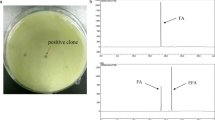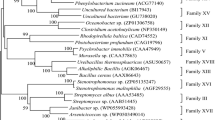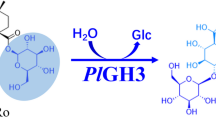Abstract
A C–C hydrolase gene (bphD LA-4 ) from strain Dyella ginsengisoli LA-4 was cloned and expressed in Escherichia coli BL21 (DE3). BphDLA-4 together with another hydrolase MfphALA-4, which derived from the same strain, possessed esterase activities. p-Nitrophenyl butyrate was the best substrate for both enzymes. BphDLA-4 had high catalytic efficiency to p-nitrophenyl benzoate, whereas MfphALA-4 had no activity. Homology modeling and docking studies demonstrated that the proper hydrogen bond interaction was important for the reactivity of specific substrate.
Similar content being viewed by others
Avoid common mistakes on your manuscript.
Introduction
The α/β-hydrolase superfamily is constituted of enzymes with similar folds but different catalytic functions (Jochens et al. 2011). These enzymes can catalyze various hydrolytic reactions on a broad range of substrates, such as esters (lipase/esterase), amides (amidase), epoxides (epoxide hydrolase) and alkyl halides (dehalogenase). The catalytic promiscuity of the α/β-fold hydrolase has drawn great attention because the enzyme can catalyze distinctly different chemical transformations in a single active site (Bornscheuer and Kazlauskas 2004; Hult and Berglund 2007; Leitgeb and Nidetzky 2010). For example, the esterase from Bacillus subtilis not only catalyzes the C–O ester bond but C–N amide bond cleavage (Kourist et al. 2008). Proline aminopeptidase has a normal hydrolysis activity towards the C–N bond in proline amides but can also hydrolyze the P–F bond in diisopropyl fluorophosphates (Bornscheuer and Kazlauskas 2004). The common mechanism of these reactions, nucleophilic attack, provides the possibility of the catalytic promiscuity (Khersonsky and Tawfik 2010).
C–C bond hydrolases (E.C. 3.7.1.8), which are identified in the degradation pathway of aromatic compounds, can catalyze a rare C5–C6 bond cleavage of the 2-hydroxy-6-oxo-hexa-2,4-dienoate (HODA) (Seah et al. 1998). As an exception, they have a different hydrolytic mechanism from most members of the α/β-hydrolase superfamily. The serine of catalytic triad does not act as a nucleophile in the catalytic reaction and obeys the general base mechanism (Speare et al. 2004). However, a C–C hydrolase, MhpC from Escherichia coli, catalyses the hydrolysis of a monoethyl adipate ester, while another C–C hydrolase, BphD from Burkholderia xenovorans LB400, could hydrolyze p-nitrophenyl esters (Scheme 1), which expanded our insights into the catalytic promiscuity of C–C hydrolases (Li and Bugg 2007; Li et al. 2008). Therefore, it is necessary to further explore whether the esterase activities exist extensively in different C–C hydrolases and the possible enzyme–ester substrate interactions.
Previously, the whole biphenyl degradation gene cluster from strain Dyella ginesengisoli LA-4 was obtained, and a recombinant C–C bond hydrolase MfphALA-4 was purified and characterized (Li et al. 2010). In this study, the cloning and heterologous expression of another C–C bond hydrolase BphDLA-4 in E. coli were performed. The esterase activities of purified MfphALA-4 and BphDLA-4 were determined using p-nitrophenyl esters. Furthermore, the enzyme–substrate interactions were simulated with homology modeling and molecular docking in order to explain the substrate specificities.
Materials and methods
Chemicals, plasmids and growth conditions
All the p-nitrophenyl esters were purchased from Sigma-Aldrich. 2-Hydroxy-6-oxo-6-methyl-hexa-2,4-dienoate (6M-HODA), HODA and 2-hydroxy-6-oxo-6-phenylhexa-2,4-dienoate (HOPDA) were enzymatic synthesized using BphC (see Seah et al. 1998). All other chemicals were of analytical grade. E. coli JM109 (TaKaRa) and E. coli BL21 (DE3)/pET28-a (Novagen) were used for plasmid construction and gene expression, respectively. E. coli were grown in Luria–Bertani medium at 37°C.
Cloning, expression and purification of BphDLA-4
The gene encoding BphDLA-4 was amplified by standard PCR using the genomic DNA of D. ginsengisoli LA-4 as template. PCR primers were: BphD-F (5′-TCGCGGATCCGAATTCATGACGGCACTTACCGAAAG-3′) and BphD-R (5′-GTGCGGCCGCAAGCTTTCATTCATTCATGCTTGAGAAAAT-3′). The purified PCR product was inserted into the pET28-a vector and transformed into E. coli BL21 (DE3). The recombinant E. coli BL21 (DE3) harboring plasmid (pET28-a-bphD) was grown at 37°C in LB medium with 30 μg kanamycin/ml until the OD600 reached 0.4–0.6, and then induced with 1 mM IPTG at 37°C for 3 h. The cells were harvested by centrifugation at 5,000×g for 10 min at 4°C, suspended in 200 mM sodium phosphate buffer (PBS, pH 7.0), and finally disrupted by sonication. After centrifugation (58,545×g, 20 min, 4°C), the supernatants were used as the crude extracts and purified by a prepacked His-Trap FF column using an ÄKTA Explorer 100 chromatography system. The target peak fraction was pooled and dialyzed overnight to remove imidazole. The molecular weight and purity of the enzyme were estimated by SDS-PAGE. Protein concentration was determined by Bradford method using bovine serum albumin as standard.
Enzyme assays of BphDLA-4 and MfphALA-4
The esterase activity and C–C hydrolase activity were determined in 200 mM PBS (pH 7.0) containing 50 μM substrate. The reactions were initiated by adding the purified BphDLA-4 and MfphALA-4, and the activity was determined spectrophotometrically at 405 nm (p-nitrophenol), 388 nm (6 M-HODA), 375 nm (HODA) and 434 nm (HOPDA). The optimal pH was assayed by incubating the enzymes in different buffers for 30 min. The buffer solutions used were PBS (pH 6.0–7.5, 200 mM) and Tris/HCl (pH 8.0–9.0, 200 mM). The thermal stability of MfphALA-4 and BphDLA-4 were determined by heating the enzymes for 30 min at different temperatures and stopped by immersion the solutions in an ice bath. To investigate the stability in the presence of denaturing agents, i.e. SDS, diethylpyrocarbonate (DEPC) and PMSF, the enzymes were incubated for 30 min in solutions which contained varying denaturant concentrations. One unit of enzymatic activity was defined as the quantity of enzyme required to consume 1 μM HODAs or produce 1 μM p-nitrophenol/min. For kinetic assays, appropriate equations were fitted to the initial velocities determined at different substrate concentrations by using the non-linear regression function of Origin 7.0.
Sequence analysis, homology modeling and docking
The sequence of BphDLA-4 was obtained from GenBank (ACH87189.1). Sequence analysis was conducted using BLAST (http://blast.ncbi.nim.nih.gov/Blast.cgi). The 3D model of BphDLA-4 and MfphALA-4 was built with SWISS-MODEL using the crystal structure of BphDLB400 (PDB ID: 2OG1) and CumDIP01 (PDB ID: 1IUP) as template, respectively. The initial models were further optimized by Gromacs 4.5.1. The quality of the 3D model was evaluated by PROCHECK analysis and Verify3D. To perform docking studies, the coordinate files of ligands were prepared in PRODRG server (http://davapc1.bioch.dundee.ac.uk/prodrg/index.html). AutoDock 4.2 was employed to generate ligand–protein complexes and calculate the relative binding free energy. The results were visualized using the PyMOL program.
Results and discussion
Cloning and sequence analysis of BphDLA-4
The gene encoding BphDLA-4 (858 bp) was successfully obtained by direct PCR method. The deduced amino acid sequence, composed of 286 residues, exhibited the highest similarity (89%) with C–C bond hydrolase from Pseudomonas pseudoalcaligenes KF707. According to the sequence alignment of BphDLA-4 and related C–C bond hydrolases, the residues Ser112, Asp237 and His265 formed the catalytic triad, which were conserved in all C–C bond hydrolases.
Purification and biochemical characterization of BphDLA-4 and MfphALA-4
The BphDLA-4 was successfully expressed in a soluble form at 37°C or lower. The protein was purified to homogeneity by nickel chelate affinity chromatography, and dialysed at 4°C overnight. The purified protein with a molecular weight of 34 ± 1 kDa was a little larger than the prediction molecular weight deduced from the sequence (32 kDa), which was due to the existence of N-terminal histidine tag (Fig. 1). The purified BphDLA-4 could utilize p-nitrophenyl acetate (PNPA), p-nitrophenyl butyrate (PNPB) and p-nitrophenyl benzoate (PNPBen) as substrates. However, the purified MfphALA-4 could only catalyze PNPA and PNPB hydrolysis, but had no detectable activity toward PNPBen. Using PNPB as substrate, the optimal pH for MfphALA-4 and BphDLA-4 were both 7.0, while the BphDLA-4 possessed higher thermostability than MfphALA-4. The optimal temperature for the esterase activity of BphDLA-4 and MfphALA-4 were 52 and 44°C, respectively (Fig. 2). SDS, DEPC and PMSF could significantly inhibit the esterase activities of MfphALA-4 and BphDLA-4, which indicated that the oligomeric form of native proteins, His265 and Ser112, were indispensable for esterase activity.
SDS-PAGE of purified BphDLA-4. E. coli containing pET28-a-bphD LA-4 was lysed and run through Ni–NTA resin. The column was then subsequently washed with increasing concentrations of imidazole (100–325 mM) in stepwise increments. Lane M Protein weight marker (broad), lane 1 lysate, lane 2 100 mM imidazole, lane 3, 200 mM imidazole, lane 4 325 mM imidazole
Thermal stabilities of BphDLA-4 and MfphALA-4. The enzyme solutions were pre-incubated in 0.2 M sodium phosphate buffer (pH 7.0) for 30 min and immersed in an ice bath before determined at 405 nm. The residual activity was expressed as the percentage of the activity of enzyme incubated at optimal temperature (8.2 U/mg for BphDLA-4 at 52°C, 4.5 U/mg for MfphALA-4 at 44°C), which were taken as 100%
Apparent kinetics of BphDLA-4 and MfphALA-4
The kinetic parameters of BphDLA-4 and MfphALA-4 on esters and HODAs were illustrated in Table 1. For BphDLA-4, all the tested p-nitrophenyl esters and HODAs were readily hydrolyzed, among which BphDLA-4 exhibited the highest catalytic efficiency for PNPB (esterase activity) and HOPDA (C–C hydrolase activity). However, the catalytic efficiency for ester hydrolysis were 1.7 (PNPA), 25.5 (PNPB) and 11.2 (PNPBen) percent of the HOPDA hydrolysis, respectively. On the other hand, MfphALA-4 could hydrolyze PNPA and PNPB effectively but not PNPBen. Interestingly, the catalytic efficiency of MfphALA-4 for ester hydrolysis were 2.8-fold (PNPA) and 6.4-fold (PNPB) of the 6M-HODA hydrolysis, which demonstrated that the physiological role of MfphALA-4 needed to be further clarified.
Homology modeling and molecular docking
In order to understand the enzyme–substrate interactions, the structure models of BphDLA-4 and MfphALA-4 were constructed by homology modeling and modified through energy minimization. The overall structures of two enzymes were canonical α/β-hydrolase fold, and the conserved catalytic triad was located at the cleft between the lid and core domain (Fig. 3). The quality validation indicated that the comparative models were suitable for further docking studies.
Homology modeling of BphDLA-4 and MfphALA-4. a Three-dimensional carton model of BphDLA-4. The crystal structure of BphDLB400 (PDB ID: 2OG1) was used as the template (88% amino acid sequence identity). b Three-dimensional carbon model of MfphALA-4. The crystal structure of CumDIP01 (PDB ID: 1IUP) was used as the template (62% amino acid sequence identity). The lid domain, core domain and catalytic triad were labeled in orange, blue and red, respectively
Molecule docking studies were used to explain different reactivity of substrates according to one criterion: the hydrogen bond formed between serine catalytic triad and substrate. The serine catalytic triad of C–C bond hydrolase had been inferred to play an important role in stabilizing the intermediate via hydrogen-bonding (Li et al. 2007). Hydrogen bonds involved in hydroxyl side-chain of Ser112 and carbonyl oxygen atom of ligands were observed in BphDLA-4-PNPBen (Fig. 4c), BphDLA-4-HOPDA (Fig. 4d), MfphALA-4-PNPA (Fig. 4e), MfphALA-4-PNPB (Fig. 4f) and MfphALA-4-6M-HODA (Fig. 4h). For both BphDLA-4-PNPA and BphDLA-4-PNPB (Fig. 4a, b), the hydrogen-bond interaction was observed between Gly139 and ligand, which had been proved to stabilize interaction between HOPDA and BphDLB400 (Horsman et al. 2006). In particular, an improper hydrogen bond was formed between Ser106 of MfphALA-4 and phenolic oxygen atom of PNPBen (Fig. 4g), which should prevent the necessary rotation of oxyanion intermediate, resulting in an undetectable reactivity of PNPBen.
2D view of enzyme–substrate interactions. The hydrogen bonds were labeled by dash line. The non-ligand residues and corresponding atoms in ligand involved in hydrophobic contact were labeled as spline segment. a BphD-PNPA. b BphD-PNPB. c BphD-PNPBen. d BphD-HOPDA. e MfphA-PNPA. f MfphA-PNPB. g MfphA-PNPBen. h MfphA-6M-HODA
Conclusions
Both hydrolases BphDLA-4 and MfphALA-4 hydrolyzed specific p-nitrophenyl esters with different specificities. According to the docking studies, the proper hydrogen bond formed between substrates and hydrolases were prerequisite for esterase activities.
References
Bornscheuer UT, Kazlauskas R (2004) Catalytic promiscuity in biocatalysis: using old enzymes to form new bonds and follow new pathways. Angew Chem Int Ed Engl 43:6032–6040
Horsman GP, Ke J, Dai S, Seah SY, Bolin JT, Eltis LD (2006) Kinetic and structural insight into the mechanism of BphD, a C–C bond hydrolase from the biphenyl degradation pathway. Biochemistry 45:11071–11186
Hult K, Berglund P (2007) Enzyme promiscuity: mechanism and applications. Trends Biotechnol 25:231–238
Jochens H, Hesseler M, Stiba K, Padhi SK, Kazlauskas RJ, Bornscheuer UT (2011) Protein engineering of α/β-hydrolase fold enzymes. Chembiochem 12:1508–1517
Khersonsky O, Tawfik DS (2010) Enzyme promiscuity: a mechanistic and evolutionary perspective. Annu Rev Biochem 79:471–505
Kourist R, Bartsch S, Fransson L, Hult K, Bornscheuer UT (2008) Understanding promiscuous amidase activity of an esterase from Bacillus subtilis. Chembiochem 9:87–89
Leitgeb S, Nidetzky B (2010) Enzyme catalytic promiscuity: the nonheme Fe2+ center of beta-diketone-cleaving dioxygenase Dke1 promotes hydrolysis of activated esters. Chembiochem 11:502–505
Li JJ, Bugg TD (2007) Investigation of a general base mechanism for ester hydrolysis in C–C hydrolase enzymes of the alpha/beta-hydrolase superfamily: a novel mechanism for the serine catalytic triad. Org Biomol Chem 5:507–513
Li C, Hassler M, Bugg TD (2008) Catalytic promiscuity in the alpha/beta-hydrolase superfamily: hydroxamic acid formation, C–C bond formation, ester and thioester hydrolysis in the C–C hydrolase family. Chembiochem 9:71–76
Li A, Qu YY, Zhou JT, Ma F, Zhou H, Shi SN (2010) Characterization of a novel meta-fission product hydrolase from Dyella ginsengisoli LA-4. Proc Biochem 45:94–100
Seah SY, Terracina G, Bolin JT, Riebel P, Snieckus V, Eltis LD (1998) Purification and preliminary characterization of a serine hydrolase involved in the microbial degradation of polychlorinated biphenyls. J Biol Chem 273:22943–22949
Speare DM, Fleming SM, Beckett MN, Li JJ, Bugg TD (2004) Synthetic 6-aryl-2-hydroxy-6–ketohexa -2,4-dienoic acid substrates for C–C hydrolase BphD: investigation of a general base catalytic mechanism. Org Biomol Chem 2:2942–2950
Acknowledgments
The authors would like to thank the National Natural Science Foundation of China (Nos. 21176040 and 51078054) for their financial supports.
Author information
Authors and Affiliations
Corresponding author
Rights and permissions
About this article
Cite this article
Zhou, H., Qu, Y., Kong, C. et al. Promiscuous esterase activities of the C–C hydrolases from Dyella ginsengisoli . Biotechnol Lett 34, 1107–1113 (2012). https://doi.org/10.1007/s10529-012-0880-0
Received:
Accepted:
Published:
Issue Date:
DOI: https://doi.org/10.1007/s10529-012-0880-0










